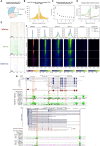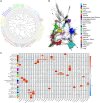Transcription initiation mapping in 31 bovine tissues reveals complex promoter activity, pervasive transcription, and tissue-specific promoter usage
- PMID: 33722934
- PMCID: PMC8015843
- DOI: 10.1101/gr.267336.120
Transcription initiation mapping in 31 bovine tissues reveals complex promoter activity, pervasive transcription, and tissue-specific promoter usage
Abstract
Characterizing transcription start sites is essential for understanding the regulatory mechanisms that control gene expression. Recently, a new bovine genome assembly (ARS-UCD1.2) with high continuity, accuracy, and completeness was released; however, the functional annotation of the bovine genome lacks precise transcription start sites and contains a low number of transcripts in comparison to human and mouse. By using the RAMPAGE approach, this study identified transcription start sites at high resolution in a large collection of bovine tissues. We found several known and novel transcription start sites attributed to promoters of protein-coding and lncRNA genes that were validated through experimental and in silico evidence. With these findings, the annotation of transcription start sites in cattle reached a level comparable to the mouse and human genome annotations. In addition, we identified and characterized transcription start sites for antisense transcripts derived from bidirectional promoters, potential lncRNAs, mRNAs, and pre-miRNAs. We also analyzed the quantitative aspects of RAMPAGE to produce a promoter activity atlas, reaching highly reproducible results comparable to traditional RNA-seq. Coexpression networks revealed considerable use of tissue-specific promoters, especially between brain and testicle, which expressed several genes in common from alternate loci. Furthermore, regions surrounding coexpressed modules were enriched in binding factor motifs representative of each tissue. The comprehensive annotation of promoters in such a large collection of tissues will substantially contribute to our understanding of gene expression in cattle and other mammalian species, shortening the gap between genotypes and phenotypes.
© 2021 Goszczynski et al.; Published by Cold Spring Harbor Laboratory Press.
Figures






Similar articles
-
Genome-wide identification of tissue-specific long non-coding RNA in three farm animal species.BMC Genomics. 2018 Sep 18;19(1):684. doi: 10.1186/s12864-018-5037-7. BMC Genomics. 2018. PMID: 30227846 Free PMC article.
-
A promoter-level mammalian expression atlas.Nature. 2014 Mar 27;507(7493):462-70. doi: 10.1038/nature13182. Nature. 2014. PMID: 24670764 Free PMC article.
-
Antisense Transcription in Loci Associated to Hereditary Neurodegenerative Diseases.Mol Neurobiol. 2019 Aug;56(8):5392-5415. doi: 10.1007/s12035-018-1465-2. Epub 2019 Jan 4. Mol Neurobiol. 2019. PMID: 30610612 Free PMC article.
-
Expression Specificity of Disease-Associated lncRNAs: Toward Personalized Medicine.Curr Top Microbiol Immunol. 2016;394:237-58. doi: 10.1007/82_2015_464. Curr Top Microbiol Immunol. 2016. PMID: 26318140 Review.
-
The human CYP19 (aromatase P450) gene: update on physiologic roles and genomic organization of promoters.J Steroid Biochem Mol Biol. 2003 Sep;86(3-5):219-24. doi: 10.1016/s0960-0760(03)00359-5. J Steroid Biochem Mol Biol. 2003. PMID: 14623514 Review.
Cited by
-
An overview of recent technological developments in bovine genomics.Vet Anim Sci. 2024 Jul 23;25:100382. doi: 10.1016/j.vas.2024.100382. eCollection 2024 Sep. Vet Anim Sci. 2024. PMID: 39166173 Free PMC article. Review.
-
Large-Scale Multiplexing Permits Full-Length Transcriptome Annotation of 32 Bovine Tissues From a Single Nanopore Flow Cell.Front Genet. 2021 May 20;12:664260. doi: 10.3389/fgene.2021.664260. eCollection 2021. Front Genet. 2021. PMID: 34093657 Free PMC article.
-
Identification of novel cattle (Bos taurus) genes and biological insights of their function in pre-implantation embryo development.BMC Genomics. 2024 Aug 9;25(1):775. doi: 10.1186/s12864-024-10685-5. BMC Genomics. 2024. PMID: 39118001 Free PMC article.
-
Improving the annotation of the cattle genome by annotating transcription start sites in a diverse set of tissues and populations using Cap Analysis Gene Expression sequencing.G3 (Bethesda). 2023 Aug 9;13(8):jkad108. doi: 10.1093/g3journal/jkad108. G3 (Bethesda). 2023. PMID: 37216666 Free PMC article.
-
Four Target Resequencing for the Bovine Major Histocompatibility Complex Region. Proof of Concept.HLA. 2025 Feb;105(2):e70057. doi: 10.1111/tan.70057. HLA. 2025. PMID: 39991974 Free PMC article.
References
Publication types
MeSH terms
Substances
LinkOut - more resources
Full Text Sources
Other Literature Sources
Miscellaneous
